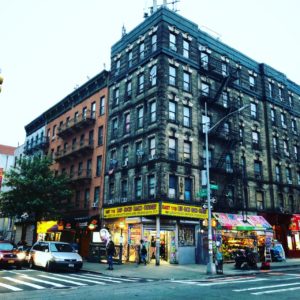“In The Heights” by Lin Manuel Miranda is a celebration of an Upper Manhattan Latino Community. Unsurprisingly, the musical’s action centers on a bodega, a New York convenience store that is as much a community center as a place to pick up a quart of milk.
But for non-New Yorkers, even Spanish speakers, the term bodega may be confusing. Originating in Spain, “bodega” means a wine cellar or hull of a ship. It was only in Cuba that “bodega” came to mean convenience store. In New York, the first bodegas appear in the 1920s. Although using a Cuban word, they sold comfort food to Puerto Rican factory workers. After WWII, as the Puerto Rican community grew, bodegas became commonplace, according to Carlos Sanabria, author of “The Bodega: A Cornerstone of Puerto Rican Barrios.” The book documents the stores that provided hard to find Puerto Rican staples: herbs like cilantro and recao; yucca, music records; and perfectly ripe avocados. But the shops went beyond material needs. Sanabria says, “the bodega was emblematic of recent migrants’ need to forge relations and seek community in a new cultural environment.”

In the Dominican Republic, small groceries are called “colmados.“ Nonetheless, by the 1990s, Dominican Immigrants, like Usnavi, the protagonist of “In The Heights,” had taken over many of the city’s bodegas. The new entrepreneurs embraced both the nomenclature and culture of the neighborhood institutions, as reflected in Usnavi’s shop, City Mart Tropical Products. Since Miranda drafted the musical in 1999, New York bodegas have continued to evolve. They’ve stopped being solely Hispanic specialty shops and became a working-class New York thing with many owned by immigrants from Yemen and elsewhere beyond the Caribbean–making “In The Heights” more relatable across the city.
What bodegas sell has also changed. In 1993, Oswald Rivera published, “Puerto Rican Cuisine in America: Nuyorican and Bodega Recipes.” It was understood that “bodega recipes” meant Puerto Rican staples like asopaos and carne mechada, made with fresh ingredients found in bodegas. Today, the neighborhood Mom and Pop’s have shifted from carrying fresh herbs, fruits and vegetables, and are more associated with unhealthy snacks and prepared food like bacon, egg and cheese on rolls and chopped cheese, heros of ground beef with melted cheese. In working class neighborhoods that have long depended on bodegas for daily groceries, this has contributed to obesity and health issues. New York City health officials track the ratio of bodegas to supermarkets as an indicator of a community’s access to healthy food. In 2017, the wealthy Upper West Side had three bodegas for every one supermarket compared to Bedford Stuyvesant, Brooklyn with a startling ratio of 57:1.
Despite the public health concerns, New Yorkers love their bodegas. They just can’t agree with how to define them. Without being exclusively Latino, it’s open to debate what is a bodega. Some point to specific menu items and the 24-hour availability of loose cigarettes, while others require a resident cat. In general, it’s agreed upon that bodegas are unpretentious, affordable, and give a neighborhood feel in a big city. For Sanabria, who grew up in East Harlem, this definition sounds right. It’s how he describes local bodegas that anchored his family life in the 1950s. In a presentation of his book at Hunter College a couple years ago, he reflected on a New York Times article that quoted non-Spanish speaking New Yorkers describing their local convenient stores as places of comfort and belonging. “The term bodega was used as opposed to any term that could have been used,” he glowed. He found it to be a testimony to the contributions of the original Puerto Rican bodegas. Linguists call words adapted from foreign languages loan words. Bodegas weren’t lent, they were gifted.
Andrew Silverstein writes about New York and is co-Founder of Streetwise New York Tours.





